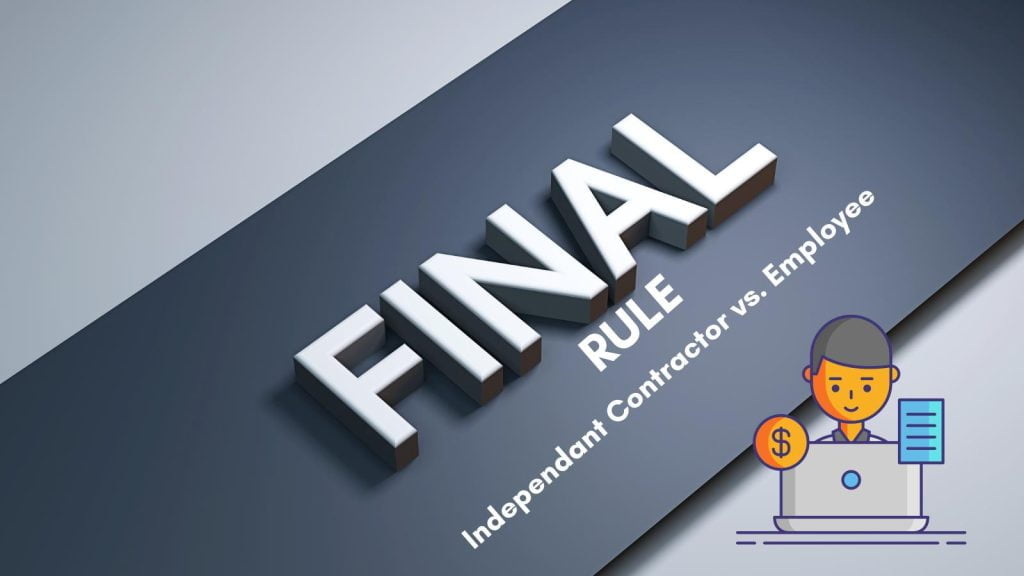The U.S. Department of Labor recently issued a final rule that will force companies to treat some workers as employees rather than less expensive independent contractors. This development has significant implications for small business owners, affecting how they classify their workforce and the potential impact on their operations and bottom line with independent contractor vs. employee.
Table of Contents
The Final Rule and Its Impact
When it comes to the classification of independent contractor vs. employee, the U.S. Department of Labor has long been at the forefront of regulating this area.
Understanding the background of the final rule can provide insight into the Department’s efforts to oversee this important aspect of the workforce.
Background of the Final Rule: Independent Contractor vs. Employee
The U.S. Department of Labor has consistently sought to establish clear guidelines for distinguishing between employees and independent contractors. The gig economy and evolving work structures have prompted the need for updated regulations to ensure the fair treatment of workers.
This initiative has been a response to the changing nature of work and the need to address potential misclassification issues that could lead to unfair labor practices.
Key Provisions of the Final Rule
The final rule introduced by the U.S. Department of Labor outlines specific provisions designed to clarify the distinction between an independent contractor vs. employee.
One of the key provisions is the emphasis on the economic reality test, which evaluates the level of control and independence a worker has in their role.
Additionally, the final rule provides guidance on how to interpret and apply this test in various work scenarios, shedding light on factors that determine an individual’s classification.
Mislabeling Workers
The final rule also highlights the significance of accurate classification, as mislabeling workers can lead to disparities in benefits and protections. By delineating clear criteria, the Department aims to enhance compliance and ensure that workers receive the appropriate wage and hour protections.
This rule introduces a pivotal shift in how companies categorize their workforce, impacting various industries and sectors. There are differences between independent contractor vs. employee.
The delineation of specific criteria and guidance underscores the Department’s commitment to fostering fair labor practices and protecting the rights of workers.
By comprehensively understanding the background and key provisions of the final rule, businesses can navigate the evolving landscape of labor classification and adapt their practices to align with the Department’s regulatory framework.
Implications for Small Business Owners
Small business owners are facing significant implications following the U.S. Department of Labor’s new rule, with potential increased costs and the need to adapt to the new classification requirements.
Increased Costs for Small Businesses
The new rule may lead to higher expenses for small businesses due to the reclassification of workers.
Small business owners could face increased costs for providing employee benefits, such as healthcare, retirement plans, and paid time off.
Additionally, payroll taxes and administrative expenses may rise as more workers are classified as employees.
Adapting to the New Classification Requirements of Independent Contractor vs. Employee
Small business owners must navigate the new classification requirements by reviewing their current workforce and job roles.
It’s crucial to assess whether an independent contractor vs. employee should be reclassified as employees based on the updated criteria.
Making necessary adjustments to comply with the rule involves redefining job roles, updating contracts, and ensuring that employees are accurately classified to avoid potential legal and financial consequences.
Consulting with Legal Professionals
Seeking legal advice is essential for small business owners to ensure compliance with the updated regulations. Consulting with legal professionals specializing in labor laws can provide valuable guidance on reclassifying workers, updating contracts, and understanding the potential legal implications of the new rule.
Legal experts can also assist in developing strategies to minimize risks and protect the business from potential legal disputes or penalties.
By understanding the increased costs, adapting to new classification requirements, and seeking legal guidance, small business owners can effectively navigate the implications of the recent U.S. Department of Labor’s final rule.
Potential Challenges and Considerations of Independent Contractor vs. Employee
As a small business owner, the U.S. Department of Labor’s new rule on worker classification may pose several potential challenges and considerations that you need to be aware of.
Impact on Business Operations
The reclassification of workers from independent contractors to employees may significantly impact your day-to-day business operations. Small businesses may face increased administrative burdens, additional payroll taxes, and potential changes to benefits and insurance requirements.
To mitigate disruption, consider streamlining internal processes, implementing efficient payroll and HR systems, and seeking professional advice to navigate the complexities of this reclassification.

Employee Relations and Morale
The shift in worker classification can have a substantial impact on employee relations and morale. As workers are reclassified as employees, it is crucial to maintain open and transparent communication to address any concerns regarding changes in job status, benefits, and overall work dynamics.
To sustain a positive work environment, provide opportunities for feedback, offer support in adapting to new roles, and ensure that the transition is managed with sensitivity and fairness.
Remember, proactive planning and clear communication with employees and stakeholders are key in addressing the potential challenges associated with the reclassification of workers under the new rule.
Conclusion
In conclusion, the new final rule from the U.S. Department of Labor will have a significant impact on the classification of workers, particularly independent contractors. It’s essential for small business owners to proactively adapt to these changes to ensure compliance and avoid potential penalties.
Take the time to review your current workforce classification and seek legal counsel if needed. Stay informed about the latest developments and adjust your business practices accordingly.
Embracing these changes now will position your business for long-term success in the evolving regulatory landscape.
How will you adjust your small biz in the coming year with this final rule of independent contractor vs. employee? I’d love to hear about it in the comments below.
Independent Contractor vs. Employee: Rule Impacts Small Biz Share on X



